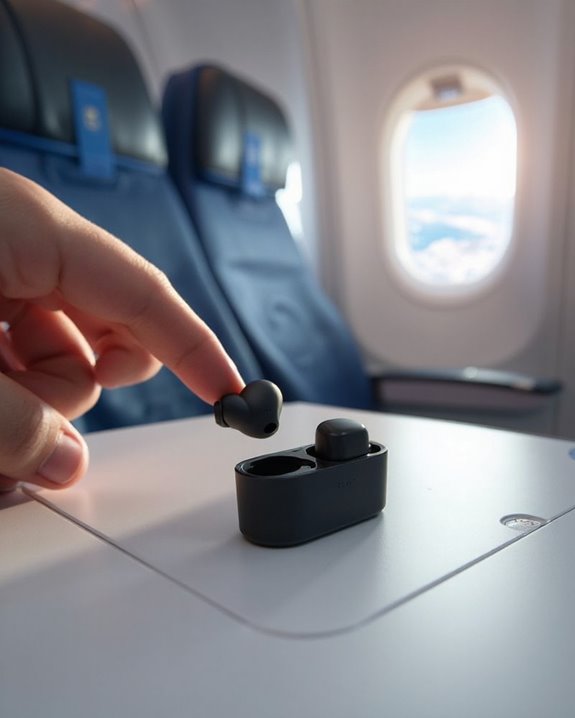Bluetooth headphones are permitted on most commercial flights, though policies vary by airline. Passengers must keep devices in airplane mode with Bluetooth manually enabled. Major carriers like Delta and United are implementing Bluetooth-compatible entertainment systems, but adoption remains inconsistent across fleets. Most airlines allow wireless headphone use during cruising altitude but restrict usage during takeoff and landing. For ideal experience, travelers should verify specific carrier policies, make sure full battery charge, and prepare alternative connection options for their journey.
Key Takeaways
- Bluetooth headphones are allowed on planes when set to airplane mode after reaching cruising altitude.
- Most major airlines like Delta and United are implementing Bluetooth-compatible entertainment systems.
- Follow airline-specific policies, as some restrict usage during takeoff and landing.
- Bluetooth operates on low-power frequencies and is unlikely to interfere with aircraft systems.
- Fully charge headphones before boarding and consider bringing wired alternatives for backup.
The Current State of Bluetooth Technology on Aircraft
The adoption of Bluetooth technology in commercial aviation represents a significant shift in how passengers experience in-flight entertainment. Major carriers like Delta and United are leading this Tech Evolution, with Delta planning an extensive rollout of Bluetooth-enabled 4K HDR systems starting in 2026, while United began implementation in 2021.
Market Penetration remains limited, with approximately 300 United aircraft currently equipped and plans to reach 800 planes by 2032. The shift typically begins in premium cabins before expanding fleetwide, creating inconsistent availability across airlines and aircraft types.
Many passengers still rely on personal Bluetooth adapters as workarounds when native support is unavailable. This stopgap solution addresses the growing preference for wireless headphones, with data showing roughly 60% of travelers prefer using their personal devices for entertainment. Advances in Bluetooth technology, such as Bluetooth 5.4 connectivity, enhance signal stability and reduce latency, improving the wireless headphone experience on planes.
Airline-Specific Policies for Wireless Headphone Use

Maneuvering the complex landscape of Bluetooth headphone policies across airlines requires passengers to understand carrier-specific regulations before boarding. Policy Evolution across carriers has created a diverse spectrum of Bluetooth allowances, with some airlines permitting wireless headphones throughout the entire flight while others restrict usage during takeoff and landing.
Alaska Airlines exemplifies this shift, planning full Bluetooth integration with their entertainment systems by Spring 2025. Meanwhile, other carriers maintain more restrictive approaches, particularly during critical flight phases.
Enforcement Methods vary greatly, from simple announcements to cabin crew monitoring. Despite FAA permissions for Bluetooth devices in airplane mode, individual airlines retain authority to implement stricter rules. Passengers should note that pilot discretion may override standard policies during turbulence or emergencies, requiring immediate compliance regardless of printed guidelines. Many newer Bluetooth devices, including headphones with Bluetooth 5.2 technology, offer ultra-low latency and stable connections, enhancing user experience even during travel.
Safety Regulations During Critical Flight Phases
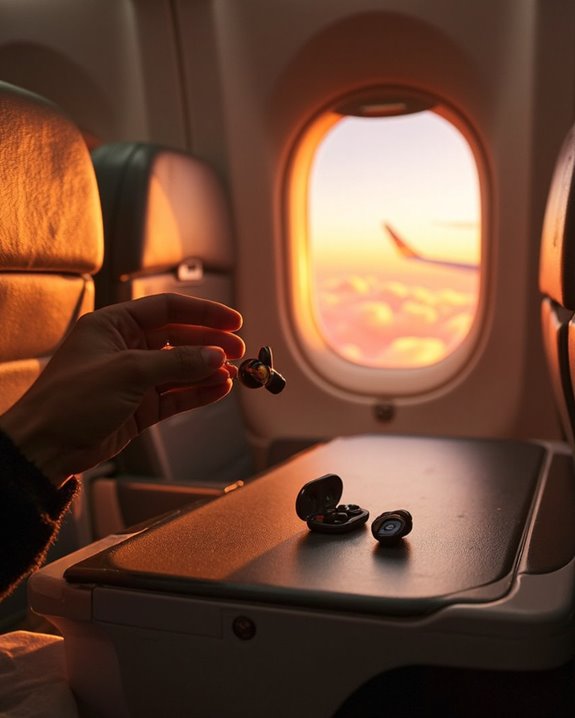
While passengers relax and enjoy in-flight entertainment, commercial aircraft operate under stringent safety protocols during what regulators designate as “critical flight phases.” These phases—primarily takeoff, initial climb, final approach, and landing—represent periods when accident risk increases substantially and flight crew attention must remain undivided.
During these times, “Sterile Cockpit” procedures prohibit non-essential communications, limiting crew interactions to operational matters only. This regulatory framework, enforced by aviation authorities worldwide, may restrict passenger activities including the use of certain electronic devices.
Emergency Protocols remain a primary focus during critical phases, with crew members positioned for immediate response. Both EU and US regulations empower the pilot-in-command to determine additional critical periods beyond those specified by standard regulations, further enhancing flight safety.
How to Use Bluetooth Headphones While Flying
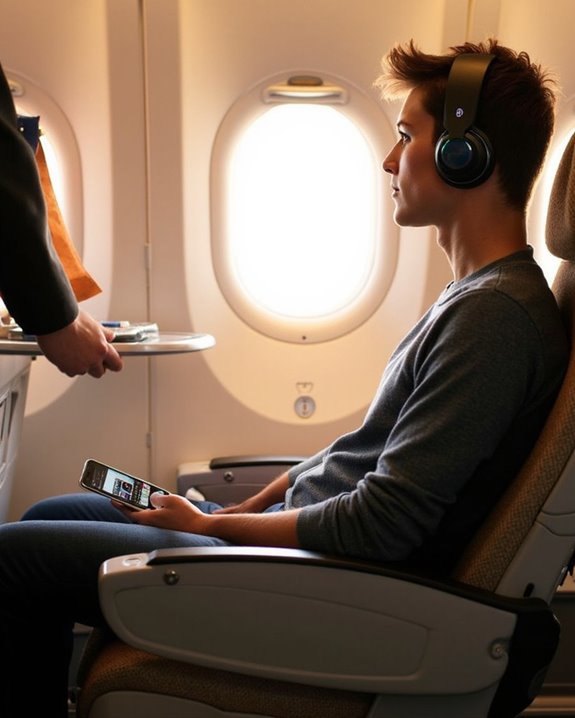
Beyond safety regulations during critical flight phases, passengers can enjoy the comfort of wireless audio with proper preparation. The process begins with setting devices to airplane mode, then manually activating Bluetooth once electronic device use is permitted.
Travelers should consider these practical steps:
- Confirm airline-specific policies before boarding
- Make sure headphones are fully charged for the entire flight
- Select appropriate ear tips for long-wearing comfort
- Learn headphone controls before takeoff to minimize mid-flight adjustments
Proper ear tip selection greatly impacts both noise isolation and comfort during extended wear. Passengers should familiarize themselves with their headphone controls—particularly volume, play/pause, and noise cancellation features—to avoid disruptions. This preparation allows travelers to seamlessly switch between listening to entertainment and remaining attentive to important cabin announcements. Additionally, choosing headphones with advanced Active Noise Cancellation technology can significantly enhance the in-flight audio experience by reducing ambient airplane noise.
Pairing Wireless Headphones With In-Flight Entertainment
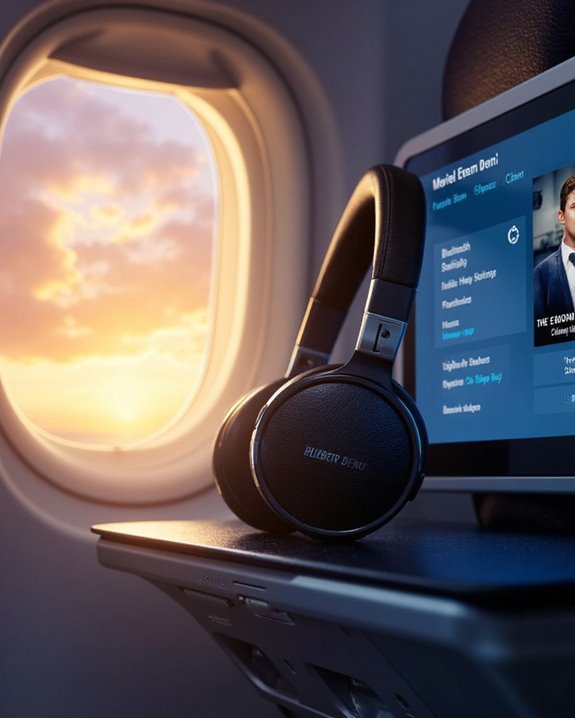
Connecting wireless headphones to an airplane’s entertainment system requires additional hardware that most travelers may not initially consider. The key component needed is a Bluetooth transmitter, which plugs into the 3.5mm headphone jack typically located on the armrest or below the screen.
The pairing process involves plugging in the transmitter and activating pairing mode on your headphones. Screen interaction may be necessary on newer systems, where passengers tap the Bluetooth symbol and select their device from a menu. Transmitter compatibility extends to virtually all Bluetooth headphones and earbuds, regardless of brand.
These transmitters generally cost around €40 and are widely available from retailers like Amazon. While the connection may occasionally experience slight audio delays during video playback, most users find the comfort and enhanced sound quality worth this minor inconvenience.
International Travel Considerations for Electronic Devices
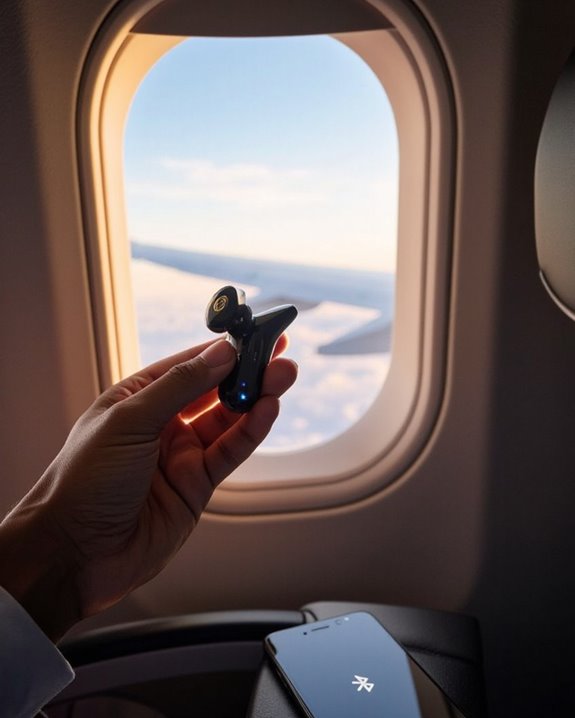
The international landscape of electronic device regulations presents significant challenges for travelers using Bluetooth headphones and other gadgets during flights. With no universal standards, restrictions vary greatly by country, airline, and airport.
While some countries implement strict Device Quotas, limiting travelers to approximately 15 electronic items with lithium batteries, others focus more on battery capacity limitations. Device size restrictions are particularly common in US and UK security protocols for certain international routes.
Travelers should also anticipate potential Customs Duties on electronic devices when crossing borders. Preparation for security screening is essential—electronics should be easily accessible in carry-on luggage, with larger devices like laptops separated for individual inspection. Familiarizing oneself with destination country regulations before travel can prevent unexpected complications at security checkpoints.
Troubleshooting Connectivity Issues at High Altitude
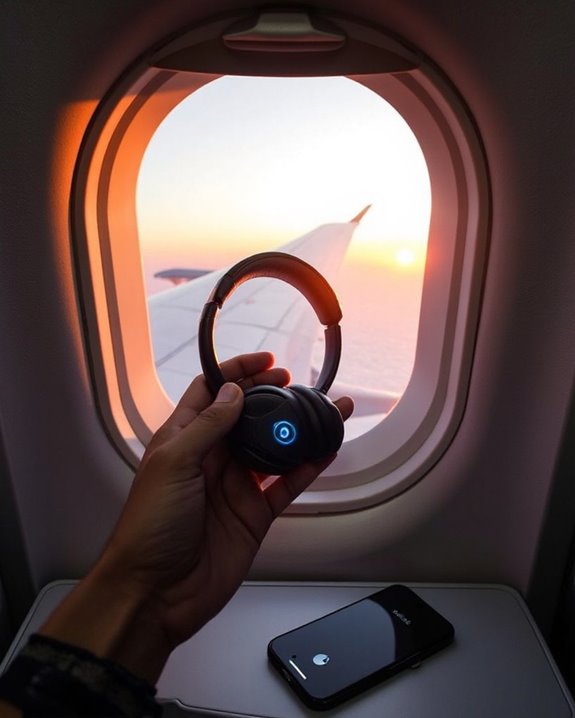
When passengers encounter Bluetooth connectivity problems at cruising altitude, several unique aircraft environmental factors may be responsible. Signal Attenuation occurs as the metal fuselage reflects and weakens Bluetooth transmissions, particularly affecting those seated far from their paired devices. Crowded cabins with numerous electronic devices create multiple Interference Sources that can disrupt the 2.4 GHz frequency band.
To resolve these issues, travelers should:
- Manually reconnect devices after enabling airplane mode
- Keep paired devices within close proximity (under 30 feet)
- Make sure headphones are fully charged before boarding
- Reset Bluetooth connections if experiencing persistent dropouts
- Consider seating location relative to entertainment systems
Battery performance may deteriorate faster at altitude due to cabin temperature variations, requiring proactive power management for longer flights.
Battery Life Management for Long-Haul Flights
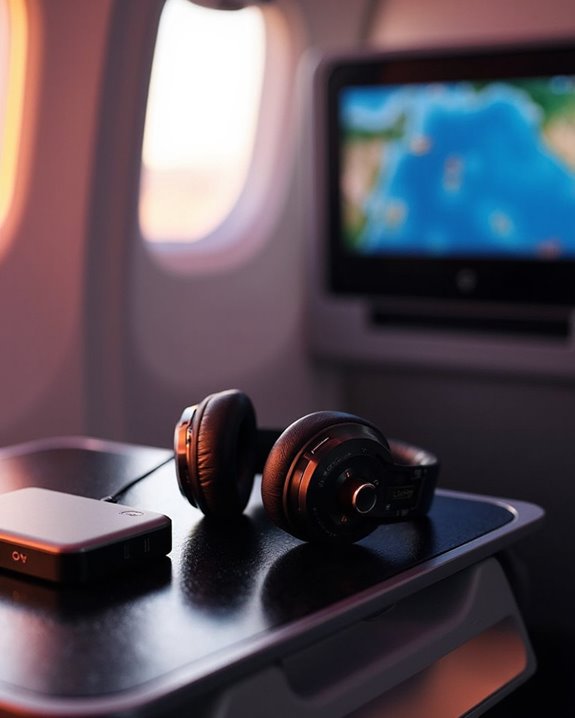
Long-haul flights spanning 8-16 hours present unique power management challenges for Bluetooth headphone users who need continuous audio enjoyment. Most modern headphones offer battery lives exceeding 20 hours, though actual performance varies based on usage patterns and enabled features.
Implementing strategic pre-flight preparation can maximize listening time:
- Fully charge headphones before boarding
- Disable power-intensive features when not needed
- Pre-pair with devices to avoid battery-draining connection processes
During the flight, conservation techniques become essential. Lowering volume levels, utilizing Power Saving modes, and monitoring battery indicators help prevent unexpected shutdowns. Many headphones now include Fast Charging capabilities, providing hours of playback after minimal charging time.
For travelers concerned about battery depletion, carrying a portable power bank and using wired mode during critical low-battery periods guarantees uninterrupted audio throughout even the longest journeys.
Alternatives When Bluetooth Use Is Restricted
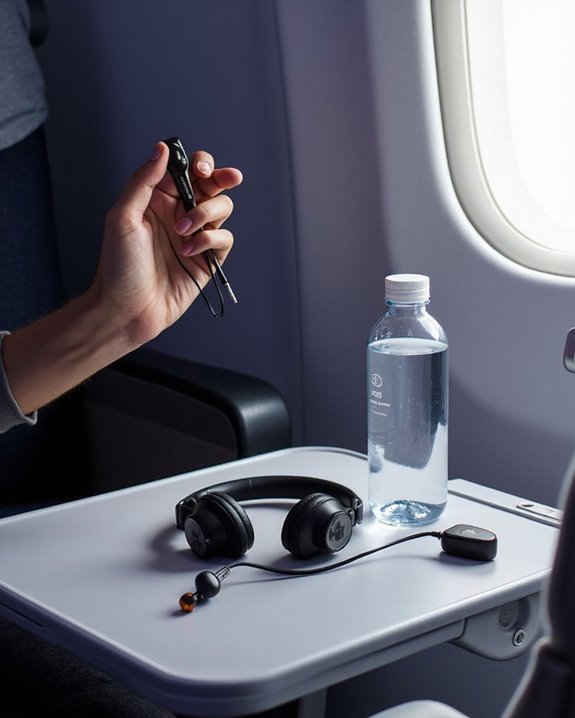
Despite their convenience, Bluetooth headphones face usage restrictions during critical flight phases such as takeoff and landing when airlines enforce electronic device limitations. Passengers should prepare by having Wired Alternatives readily available.
Traditional wired headphones provide a reliable connection without interference concerns and can often connect directly to in-flight entertainment systems. Many airlines offer complimentary wired headphones, though quality varies considerably.
Offline Options include pre-downloading content to devices before the flight, eliminating the need for streaming services that might require wireless connections. Portable media players paired with wired headphones offer another solution that complies with airline regulations.
For maximum preparedness, travelers should:
- Check specific airline policies before flying
- Carry adapters for newer devices lacking headphone jacks
- Manage cords carefully to avoid entanglement
- Consider seat location for comfortable headphone use
Frequently Asked Questions
Do Noise-Cancelling Bluetooth Headphones Affect Plane Pressure Sensors?
Noise-cancelling Bluetooth headphones do not affect plane pressure sensors. Extensive sensor testing has debunked these pressure myths, as aircraft systems operate on different frequencies and are physically shielded from weak Bluetooth signals.
Can Bluetooth Headphones Trigger Security Concerns During Border Crossings?
Bluetooth headphones rarely trigger Border Alerts or Customs Profiling during crossings. While coincidentally sharing similar wireless technology with other devices, these headphones pose minimal security concerns as they don’t interfere with screening equipment or warrant special inspection protocols.
Are There Medical Exemptions for Using Bluetooth Devices During Takeoff?
Medical exemptions exist for essential Bluetooth-enabled medical devices during takeoff. Passengers with health waivers can use devices like hearing aids with Bluetooth functionality, as long as cellular and WiFi capabilities remain disabled.
How Do Aircraft Wifi Services Affect Bluetooth Headphone Performance?
Despite sharing the 2.4 GHz band, aircraft WiFi surprisingly causes minimal disruption to headphones. However, users may experience occasional connection stability issues and increased battery drain when both services operate simultaneously.
Can Airline Staff Request Passengers Turn off Specific Bluetooth Devices?
Airline staff can issue directives requiring passengers to disable specific Bluetooth devices for safety reasons. Despite occasional passenger objections, crew instructions must be followed according to aviation regulations regardless of device interference potential.

